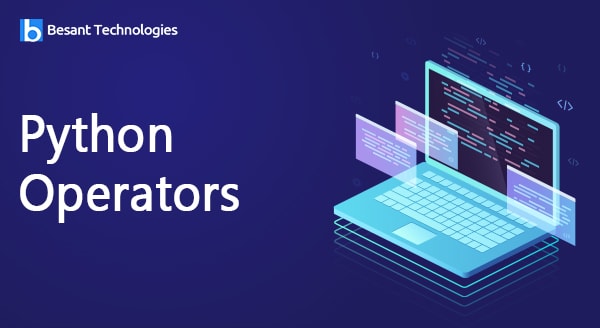
Python Operators
Guide to Python Operators
Python is a general-purpose coding language and unlike Java or C++ is used for other types of programming and software development. Python has gained an immense fan following among programmers because of the variety of tasks it can handle and user-friendly language. Python code uses English keywords which are easy to understand even for non-coders.
There are lots of reasons why you should learn this fantastic programming language. The big reason might be the huge openings Python offers to the programmers and developers. Python is the chosen programming language for many startups because of its speed in delivering timely projects and its cost-effectiveness. The first version of Python was released in 1994 and Python 2 was released in 2000. December 2008 saw the release of Python 3 with a new design to avoid duplicate modeling.
Applications of Python
Python has a wide number of uses and is compatible with any model or application.
- Web frameworks and web applications
- Operating systems
- Prototyping
- Language development
- Enterprise and business applications
- GUI based desktop applications
Advantages of Python
The Python language has diverse applications because of the wide array of features and options that it provides and some of which are:
Vast Library Support
The Python language provides a large library that covers domains like internet protocols, web services, string operations, and various operating interfaces. High-end programming codes are scripted into the language library and thus reduces the length of the codes.
Open Source Programming
Python language is approved by ASI and OSI and has an open-source license which makes it free to distribute and use the programming for commercial purposes. The Python community collaborates through hosting conferences and mailing lists and comes up with various modules for improving the programming structure.
Speed and Super Productive
Python has superior process control capabilities and provides strong integration and text mapping features and its self-testing units. Moreover, it has a clean design and has the strength of building complex network applications with a clean design.
Third-Party Hosting
The Python package index contains numerous third-party modules that make the program easy to interact with other programming languages.
User-friendly structures
Python has a built-in dictionary list that can be built to construct data structures. Python also comes equipped with high-level data typing features which lessen the use of support codes
Easy to Master and Plenty of Support
The language is extremely easy to read and master. It has a simple and clean syntax which helps beginners to utilize the language. The code style guidelines provide the basic rules of formatting code. It also comes with a rich resource of developers and programmers which helps to develop the language and evolve with regular upgrades.
Python Operators
Various kinds of special symbols that are used for logical and arithmetical computations are called Python operators. Python operators are used for finding values between two variables and the output changes according to the type of operator used in the operation. Special symbols or signs are assigned to the operators to dictate the value of the operands. Consider the example 6+4=10. Here, 6 and 4 are called operands and + is called the operator. There are many types of operators in Python and the chief ones are shown below with their symbols.

Python operators are divided into the following categories.
- Arithmetic operators
- Assignment operators
- Comparison operators
- Logical operators
- Bitwise operators
- Identity Operators
- Membership operators
Arithmetic operators
Arithmetic operators perform various s arithmetic calculations like addition, subtraction, multiplication, division, % modules, exponent, etc. You can use various functions like eval function, declare variable & calculate or call functions.
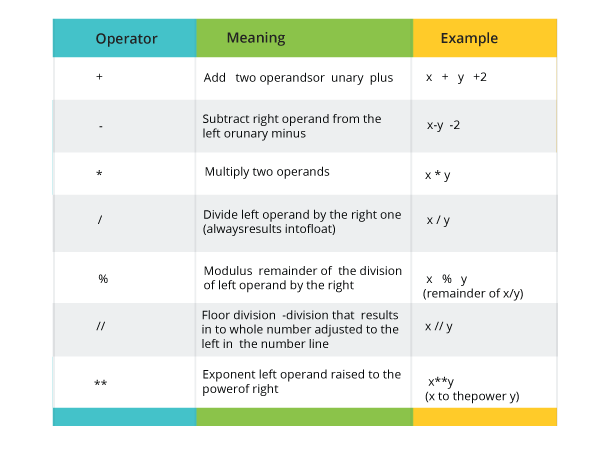
Example:
X=15 Y=4
Output:
x – y = 11
Program:
print(‘x – y =’,x-y)
2. Assignment operators
These operators are used to assign values to variables. Value assigning to variables is performed by assignment operators in python.
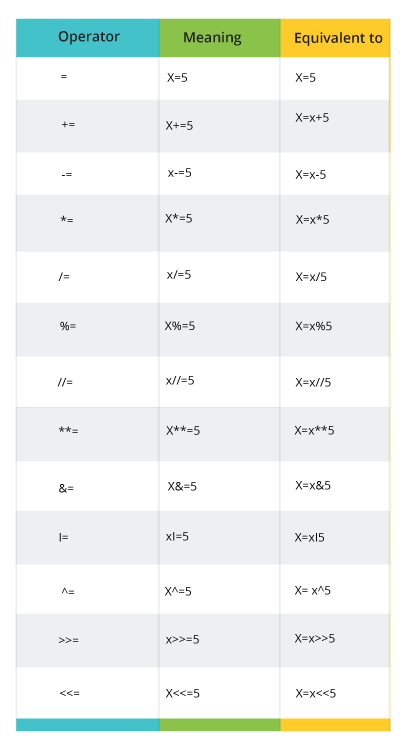
Example: =, +=,-=,*=, >>=, <<=.
3. Comparison operators
As the name suggests a comparison of values is done by comparison operators as per the condition to determine whether it’s true or false.
These operators compare values on either side of the operand and establish the relation between the two parameters. They are also known as relational operators.
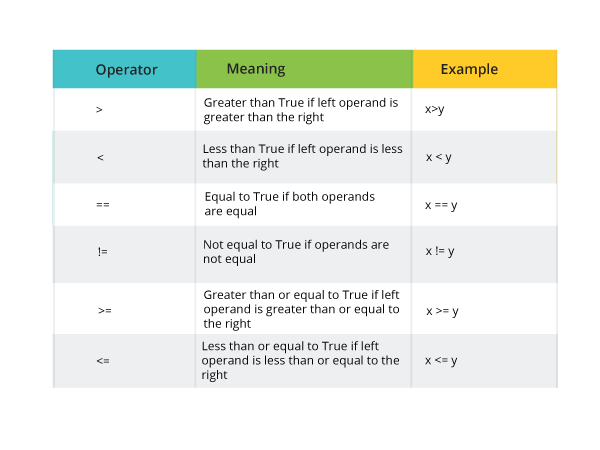
Example: ==, !=, > , < , >= ,<=
4. Logical operators
Operators used to join conditional statements are known as logical operators. Logical operators are used for conditional statements of true and false. Logical operators use and, or and not.
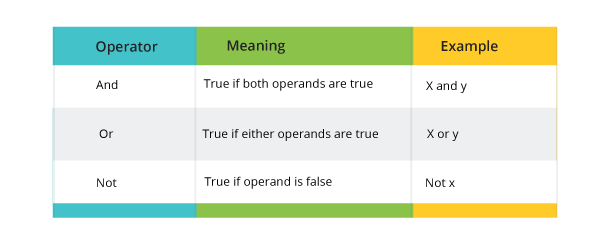
Example: And, or, not.
5. Bitwise operators
Bitwise operators act as operands on a string of binary digits. Their functions are often in bits hence they earn the name and they act as if binary digits.
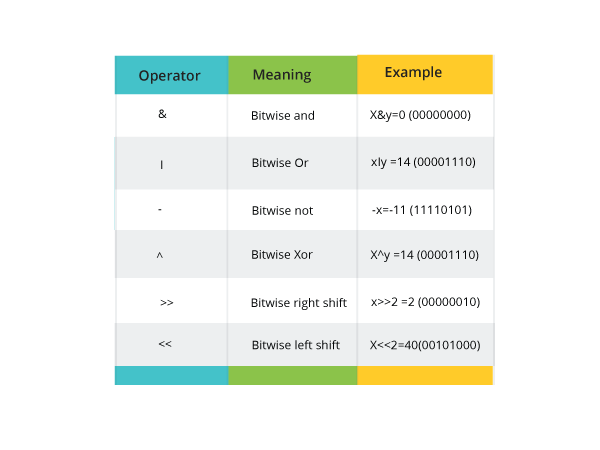
Example: &, | , ^ , <<, >> etc
6. Identity Operators
These are special operators and uses is and are not in Python. These are used to check if two values are located in the same memory.
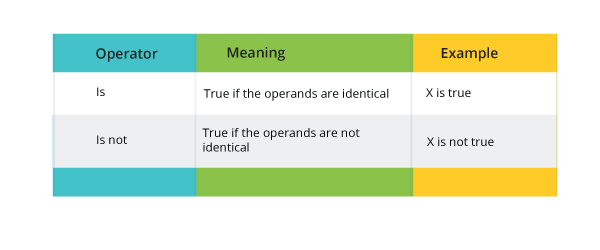
7. Membership operators
In and not in are the membership operators in Python and used to check the value in a sequence.
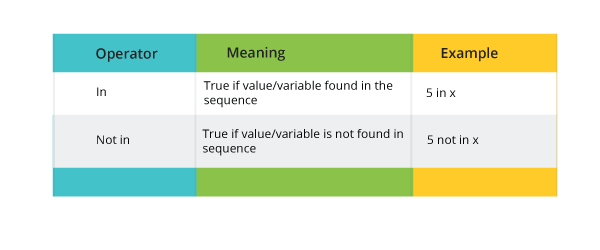
So, in this blog, you have gone through the basics of Python programming language and the operators used in the system. This would help you to develop a fundamental concept of the programming and help you proceed further towards a structured learning approach in the language.
Related Blogs:
- Brief Overview of Python Language
- Python Career opportunities
- Python Break Continue
- Python Control Flow
- Python Data Types
- Python Dictionary
- Python Exception Handling
- Python File
- Python Functions


